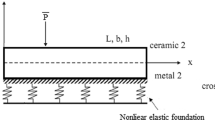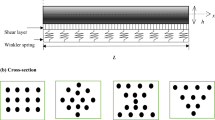Abstract
In this work, a shear deformable three-dimensional beam element that can be used to model a variety of beam-like structures in multibody applications is proposed. The absolute nodal coordinate formulation, in which global displacements and slopes are used as nodal coordinates, is employed for the finite element discretization of the beam. The element employs a cross-sectional coordinate system for the definition of strains. As shown by numerical examples, the element leads to a computationally more efficient description of elastic forces compared to the previously introduced shear deformable absolute nodal coordinate-based beam element. The results imply that the proposed element is capable of modelling highly nonlinear displacements and can be used in problems where large rotations are considered. The element also captures the effect of the rotation of the cross-section about the element longitudinal axis under a torsion load.
Similar content being viewed by others
References
Rhim, J. and Lee, S. W., ‘A vectorial approach to computational modelling of beams undergoing finite rotations’, International Journal for Numerical Methods in Engineering 41, 1998, 527–540.
Shabana, A. A., ‘Definition of the slopes and the finite element absolute nodal coordinate formulation’, Multibody System Dynamics 1, 1997, 339–348.
Jelenić, G. and Crisfield, M. A., ‘Interpolation of rotational variables in nonlinear dynamics of 3d beams’, International Journal for Numerical Methods in Engineering 43, 1998, 1193–1222.
Von Dombrowski, S., ‘Analysis of large flexible body deformation in multibody systems using absolute coordinates’, Multibody System Dynamics 8, 2002, 409–432.
Omar, M. A. and Shabana, A. A., ‘A two-dimensional shear deformation beam for large rotation and deformation’, Journal of Sound and Vibration 243(3), 2001, 565–576.
Mikkola, A. M. and Shabana, A. A., ‘A nonincremental finite element procedure for the analysis of large deformations of plates and shells in mechanical system applications’, Multibody System Dynamics 9, 2003, 283–309.
Shabana, A. A. and Yakoub, Y. R., ‘Three-dimensional absolute nodal coordinate formulation for beam elements: Theory’, Journal of Mechanical Design 123, 2001, 606–613.
Yakoub, Y. R. and Shabana, A. A., ‘Three-dimensional absolute nodal coordinate formulation for beam elements: Implementation and applications’, Journal of Mechanical Design 123, 2001, 614–621.
Sopanen, J. and Mikkola, A., ‘Description of elastic forces in absolute nodal coordinate formulation’, Nonlinear Dynamics 34, 2003, 53–74.
Dufva, K. E., Sopanen, J. T., and Mikkola, A. M., ‘A two-dimensional shear deformable beam element based on the absolute nodal coordinate formulation’, Journal of Sound and Vibration 280(3–5), 2005, 719–738.
Shi, P., McPhee, J., and Heppler, G. R., ‘A deformation field for Euler–Bernoulli beams with applications to flexible multibody dynamics’, Multibody System Dynamics 5, 2001, 79–104.
Sharf, I., ‘Nonlinear strain measures, shape functions, and beam elements for dynamics of flexible beams’, Multibody System Dynamics 3, 1999, 189–205.
Sugiyama, H., Escalona, J. L., and Shabana, A. A., ‘Formulation of three-dimensional joint constraints using the absolute nodal coordinates’, Nonlinear Dynamics 31, 2003, 167–195.
Shabana, A. A., Dynamics of Multibody Systems, 2nd edn., Cambridge University Press, Cambridge, UK, 1998.
Bathe, K. J., Finite Element Procedures, Prentice-Hall, Englewood Cliffs, New Jersey, 1996.
Gere, J. M. and Timoshenko, S. P., Mechanics of Materials, 2nd edn., Van Nostrand Reinhold (UK), England, 1987.
Danielson, D. A. and Hodges, D. H., ‘A beam theory for large global rotation, moderate local rotation, and small strain’, Journal of Applied Mechanics 55, 1988, 179–184.
Sharf, I., ‘Geometrically nonlinear beam element for dynamics simulation of multibody systems’, International Journal for Numerical Methods in Engineering 39, 1996, 763–786.
Berzeri, M. and Shabana, A. A., ‘Development of simple models for the elastic forces in the absolute nodal coordinate formulation’, Journal of Sound and Vibration 235(4), 2000, 539–565.
Author information
Authors and Affiliations
Corresponding author
Rights and permissions
About this article
Cite this article
Dufva, K.E., Sopanen, J.T. & Mikkola, A.M. Three-Dimensional Beam Element Based on a Cross-Sectional Coordinate System Approach. Nonlinear Dyn 43, 311–327 (2006). https://doi.org/10.1007/s11071-006-8326-7
Received:
Accepted:
Issue Date:
DOI: https://doi.org/10.1007/s11071-006-8326-7




